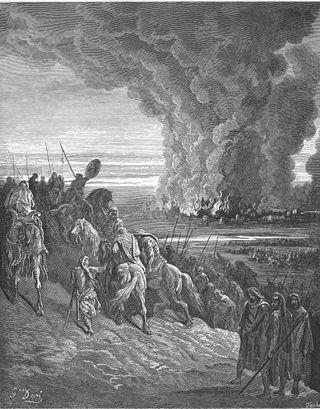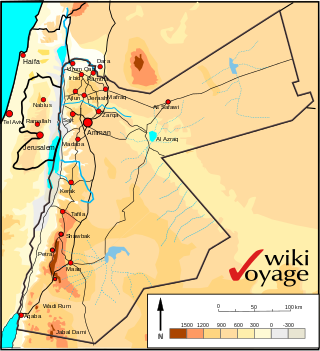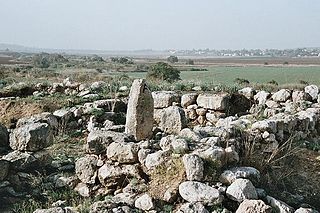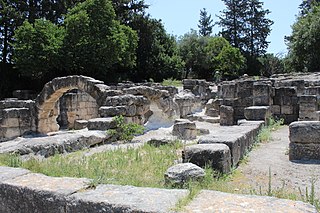This article needs additional citations for verification .(July 2007) |
Tob was the name of a place in ancient Israel, mentioned in the Hebrew Bible.
This article needs additional citations for verification .(July 2007) |
Tob was the name of a place in ancient Israel, mentioned in the Hebrew Bible.
Jephthah flees from his brothers to the "land of Tob". In Tob, Jephtha gatheres some men until his brothers want him back to fight against the Ammonites (Judges 11:3–11). The place may be the same as the one mentioned in 2 Samuel 10:6–8, named Ishtob (cf. Hebrew ish Tov). Some believe it should be translated "men of Tob", rather than "Ishtob".[ citation needed ]
There is a place named as Ṭby or Ṭubu in second millennium BCE sources, mentioned among the cities in Bashan. [1] This led Benjamin Mazar and Martin Noth to identify it with the region near "Taiyibeh", to the east of biblical Edrei (today's Daraa in southern Syria), [1] where today there is a Syrian village by this name (coordinates: 32°33'45 N, 36°14'38 E). Conder gave for his choice of Tob/Taibeh the coordinates "32° 35' N., 35° 42' E.", a place described in Brown–Driver–Briggs as 12 miles southeast of the Sea of Galilee, [2] [3] corresponding to modern-day Taibah nar Irbid in northern Jordan.
It has been suggested that the "land of Tob" was back country, used by outlaws as a place of refuge. [1]
Tob is also a town referred to in the Amarna letters, circa 1350 BCE. Among the c. 382 letters (EA 1 through EA 382) there is only one mention of the town, by the name TuBu, and in this small group of letters,[ dubious ] the leader of the town of Tubu is only referred to as the "Man" of the town, i.e. "the mayor" or "governor". Man was one of many common designations. He would have been a prince-type local leader - the chief of a tribe, clan, city, region, etc. EA letter 205 is the letter from the "Man of Tubu" and is one of 6 letters written by the same scribe.[ citation needed ]

Canaan was a Semitic-speaking civilization and region of the Southern Levant in the Ancient Near East during the late 2nd millennium BC. Canaan had significant geopolitical importance in the Late Bronze Age Amarna Period as the area where the spheres of interest of the Egyptian, Hittite, Mitanni, and Assyrian Empires converged or overlapped. Much of present-day knowledge about Canaan stems from archaeological excavation in this area at sites such as Tel Hazor, Tel Megiddo, En Esur, and Gezer.

Shechem, also spelled Sichem was an ancient city in the southern Levant. Mentioned as a Canaanite city in the Amarna Letters, it later appears in the Hebrew Bible as the first capital of the Kingdom of Israel following the split of the United Monarchy. According to Joshua 21:20–21, it was located in the tribal territorial allotment of the tribe of Ephraim. Shechem declined after the fall of the northern Kingdom of Israel. The city later regained its importance as a prominent Samaritan center during the Hellenistic period.

ʿApiru, also known in the Akkadian version Ḫabiru is a term used in 2nd-millennium BCE texts throughout the Fertile Crescent for a social status of people who were variously described as rebels, outlaws, raiders, mercenaries, bowmen, servants, slaves, and laborers.

Gibeah is the name of three places mentioned in the Hebrew Bible, in the tribes of Benjamin, Judah, and Ephraim respectively.
The name Aphek or Aphec refers to one of several locations mentioned in the Hebrew Bible as the scenes of a number of battles between the Israelites and the Arameans and Philistines:

The Ai was a Canaanite city. According to the Book of Joshua in the Hebrew Bible, it was conquered by the Israelites on their second attempt. The ruins of the city are popularly thought to be in the modern-day archeological site Et-Tell.

Mount Seir is the ancient and biblical name for a mountainous region stretching between the Dead Sea and the Gulf of Aqaba in the northwestern region of Edom and southeast of the Kingdom of Judah. It may also have marked the older historical limit of Ancient Egypt in Canaan. A place called "Seir, in the land of Shasu", thought to be near Petra, Jordan, is listed in the temple of Amenhotep III at Soleb.

Timnath or Timnah was a Philistine city in Canaan that is mentioned in the Hebrew Bible in Judges 14 and in connection with Samson. Modern archaeologists identify the ancient site with a tell lying on a flat, alluvial plain, located in the Sorek Valley ca. 7 kilometres (4.3 mi) north-west of Beit Shemesh, near moshav Tal Shahar in Israel, known in Hebrew as Tel Batash or Teluliot Batashi (plural), and in Arabic as Tell Butashi or Teleilat Batashi (plural). The site is not to be confused with either the as yet unidentified Timna from the hill country of Judah, nor with the southern copper-smelting site of Timna in the Arabah near Eilat.

Ashteroth Karnaim, also rendered as Ashtaroth Karnaim, was a city in Bashan east of the Jordan River.

Tubu is the town east of the Sea of Galilee referred to in the (body) of the Amarna letters.

Geshur was a territory in the ancient Levant mentioned in the early books of the Hebrew Bible and possibly in several other ancient sources, located in the region of the modern-day Golan Heights. Some scholars suggest it was established as an independent city-state from the middle of the tenth century BCE, maintaining its autonomy for about a century until it was annexed in the third quarter of the ninth century by Hazael, the king of Aram-Damascus.

Gath or Gat was one of the five cities of the Philistine pentapolis during the Iron Age. It was located in northeastern Philistia, close to the border with Judah. Gath is often mentioned in the Hebrew Bible and its existence is confirmed by Egyptian inscriptions. Already of significance during the Bronze Age, the city is believed to be mentioned in the El-Amarna letters as Gimti/Gintu, ruled by the two Shuwardata and 'Abdi-Ashtarti. Another Gath, known as Ginti-kirmil also appears in the Amarna letters.

Beit She'arim necropolis is an extensive necropolis of rock-cut tombs near the remains of the ancient Jewish town of Beit She'arim. In early modern times the site was the Arab village of Sheikh Bureik; it was depopulated in the 1920s as a result of the Sursock Purchases, and identified as Beit She'arim in 1936 by historical geographer Samuel Klein.

Beit She'arim or Besara was a Roman-era Jewish village from the 1st century BCE until the 3rd century CE which, at one time, was the seat of the Sanhedrin. The village was later known as Sheikh Bureik, and was depopulated in the early 1920s as a result of the Sursock Purchase.
Ramah was, according to the Hebrew Bible, a city in ancient Israel in the land allocated to the tribe of Benjamin. It was located near Gibeon and Mizpah to the West, Gibeah to the South, and Geba to the East.

Merhavia is a kibbutz in northern Israel. Located to the east of Afula, it falls under the jurisdiction of Jezreel Valley Regional Council. In 2022 it had a population of 1,331.

Sheikh Bureik, locally called Sheikh Abreik or Sheikh Ibreik in recent times, was a Palestinian Arab village located 10 miles (16 km) southeast of Haifa. Situated at an ancient site that shows evidence of habitation as early as the Iron Age, it was known as Beit She'arayim in the Roman and Byzantine periods and became an important center of Jewish learning in the 2nd century, with habitation continuing during the Early Islamic period and limited signs of activity from the Crusader period.

Khirbet et-Tibbâneh (Arabic: خربة التبانة), sometimes referred to by historical geographers as the Timnah of Judah, is a small ruin situated on a high ridge in the Judaean mountains, in the Sansan Nature Reserve, 622 metres (2,041 ft) above sea level, about 3 kilometers east of Aviezer and ca. 7 kilometers southeast of Bayt Nattif.

Tel Zeton (Hebrew: תל זיתון, also known as Tell Abu Zeitun, is an archaeological site in the Pardes Katz neighborhood of Bnei Brak, Israel. It lies 800 m south of the Yarkon River. The mound rises to a height of 9 m above its surroundings and spans an area of 2–3 dunams. The site was inhabited in the Middle Bronze Age and later in the Iron and Persian periods. Jacob Kaplan identified the fortified settlement from the Persian period as a Jewish settlement from the time of the Return to Zion in the 5th century BCE, thanks to an ostracon bearing a Hebrew name which appears in the Hebrew Bible from the time of Nehemiah, a Jewish governor appointed by the Achaemenid Empire to govern the autonomous Jewish province. The site was inhabited as late as the 10th century CE, during the Roman, Byzantine, Early Arab, and Mamluk periods.
{{cite encyclopedia}}: CS1 maint: others (link)